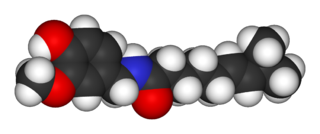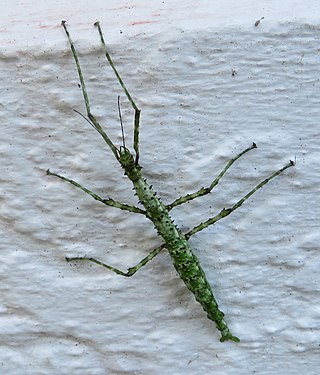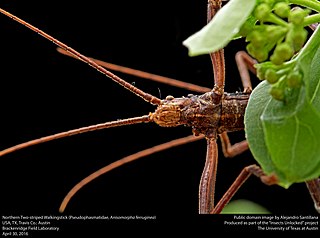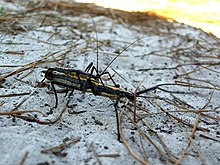
Gossypium is a genus of flowering plants in the tribe Gossypieae of the mallow family, Malvaceae, from which cotton is harvested. It is native to tropical and subtropical regions of the Old and New Worlds. There are about 50 Gossypium species, making it the largest genus in the tribe Gossypieae, and new species continue to be discovered. The name of the genus is derived from the Arabic word goz, which refers to a soft substance.

Capsaicin (8-methyl-N-vanillyl-6-nonenamide) is an active component of chili peppers, which are plants belonging to the genus Capsicum. It is a potent irritant for mammals, including humans, and produces a sensation of burning in any tissue with which it comes into contact. Capsaicin and several related amides (capsaicinoids) are produced as secondary metabolites by chili peppers, likely as deterrents against certain mammals and fungi. Pure capsaicin is a hydrophobic, colorless, highly pungent crystalline solid.

Trypanosomatida is a group of kinetoplastid unicellular organisms distinguished by having only a single flagellum. The name is derived from the Greek trypano (borer) and soma (body) because of the corkscrew-like motion of some trypanosomatid species. All members are exclusively parasitic, found primarily in insects. A few genera have life-cycles involving a secondary host, which may be a vertebrate, invertebrate or plant. These include several species that cause major diseases in humans. Some trypanosomatida are intracellular parasites, with the important exception of Trypanosoma brucei.

The Phasmatodea are an order of insects whose members are variously known as stick insects, stick-bugs, walkingsticks, stick animals, or bug sticks. They are also occasionally referred to as Devil's darning needles, although this name is shared by both dragonflies and crane flies. They can be generally referred to as phasmatodeans, phasmids, or ghost insects, with phasmids in the family Phylliidae called leaf insects, leaf-bugs, walking leaves, or bug leaves. The group's name is derived from the Ancient Greek φάσμα phasma, meaning an apparition or phantom, referring to their resemblance to vegetation while in fact being animals. Their natural camouflage makes them difficult for predators to detect; still, many species have one of several secondary lines of defense in the form of startle displays, spines or toxic secretions. Stick insects from the genera Phryganistria, Ctenomorpha, and Phobaeticus include the world's longest insects.

Asclepias is a genus of herbaceous, perennial, flowering plants known as milkweeds, named for their latex, a milky substance containing cardiac glycosides termed cardenolides, exuded where cells are damaged. Most species are toxic to humans and many other species, primarily due to the presence of cardenolides. However, as with many such plants, some species feed upon milkweed leaves or the nectar from their flowers. A noteworthy feeder on milkweeds is the monarch butterfly, which uses and requires certain milkweeds as host plants for their larvae.

Conium is a genus of flowering plants in the family Apiaceae. As of December 2020, Plants of the World Online accepts six species.

Oenothera is a genus of about 145 species of herbaceous flowering plants native to the Americas. It is the type genus of the family Onagraceae. Common names include evening primrose, suncups, and sundrops. They are not closely related to the true primroses.

Sandfly or sand fly is a colloquial name for any species or genus of flying, biting, blood-sucking dipteran (fly) encountered in sandy areas. In the United States, sandfly may refer to certain horse flies that are also known as "greenheads", or to members of the family Ceratopogonidae. The bites usually result in a small, intensely itchy bump or welt, the strength of which intensifies over a period of 5-7 days before dissipating. Moderate relief is achieved with varying success through the application of over the counter products such as Benadryl (ingested) or an analgesic cream such as After Bite. Outside the United States, sandfly may refer to members of the subfamily Phlebotominae within the Psychodidae. Biting midges (Ceratopogonidae) are sometimes called sandflies or no-see-ums. New Zealand sandflies are in the genus of sand fly Austrosimulium, a type of black fly.

Cochliomyia hominivorax, the New World screwworm fly, or simply screwworm or screw-worm, is a species of parasitic fly that is well known for the way in which its larvae (maggots) eat the living tissue of warm-blooded animals. It is present in the New World tropics. There are five species of Cochliomyia but only one species of screwworm fly in the genus is parasitic; there is also a single Old World species in a different genus. Infestation of a live vertebrate animal by a maggot is technically called myiasis. While the maggots of many fly species eat dead flesh, and may occasionally infest an old and putrid wound, screwworm maggots are unusual because they attack healthy tissue.

Asclepias curassavica, commonly known as tropical milkweed, is a flowering plant species of the milkweed genus, Asclepias. It is native to the American tropics and has a pantropical distribution as an introduced species. Other common names include bloodflower or blood flower, cotton bush, hierba de la cucaracha, Mexican butterfly weed, redhead, scarlet milkweed, and wild ipecacuanha.

Extatosoma tiaratum, commonly known as the spiny leaf insect, the giant prickly stick insect, Macleay's spectre, or the Australian walking stick, is a large species of Australian stick insect. The species has the Phasmid Study Group number PSG9.

Timema is a genus of relatively short-bodied, stout and wingless stick insects native to the far western United States, and the sole extant member of the family Timematidae. The genus was first described in 1895 by Samuel Hubbard Scudder, based on observations of the species Timema californicum.

Agathemera is a genus of stick insects in the suborder Euphasmatodea and superfamily Pseudophasmatoidea. It consists of several species limited to the mountainous regions of Argentina, Bolivia, Chile and Peru.

The Phasmatidae are a family of the stick insects. They belong to the superfamily Anareolatae of suborder Verophasmatodea.

Megacrania batesii, commonly known as the peppermint stick insect, is an unusual species of stick insect found in northeastern Australia, the Bismarck Archipelago, the Solomon Islands, New Guinea, and possibly as far north as the Philippines. It is notable for its aposematic coloration, as well as its robust chemical defense mechanism. Its common name refers to the irritating fluid — with an odor resembling peppermint — that it sprays as a defensive action from a pair of glands located at its prothorax when threatened, as well as the cylindrical, twig-like shape of its body. A member of the subfamily Megacraniinae, it was first described by English naturalist and explorer Henry Walter Bates in 1865.

Eurycnema goliath, commonly known as the goliath stick insect, or the regal stick insect, is a large species of stick insect in the family Phasmatidae, endemic to Australia and considered one of the largest species of stick insects in the country. The species has the Phasmid Study Group number PSG14.

Acanthoxyla prasina, the prickly stick insect, is a stick insect in the order Phasmatodea and the family Phasmatidae. It is native throughout New Zealand, although it is less frequently reported than "common" stick insect species. It has been introduced to Britain, predominantly Cornwall and Devon, and to the south-west region of the Republic of Ireland. It has a thorny skin, which is used as camouflage.

Acanthoxyla inermis is an insect that was described by John Salmon in 1955. Acanthoxyla inermis is included in the genus Acanthoxyla, and family Phasmatidae. No subspecies are listed. This species is native to New Zealand but has been unintentionally moved to Great Britain where it has grown a stable population and is the longest insect observed in the UK, and the most common of the stick insects that have established themselves on the island.

Anisomorpha ferruginea is a species in the family Pseudophasmatidae, in the order Phasmatodea ("walkingsticks"). Common names include "northern two-striped walkingstick", "dark walkingstick", and "prairie alligator". Anisomorpha ferruginea is found in North America. This insect can spray a defensive mist that contains a terpene dialdehyde.

Lonchodidae is a family of stick insects, with more than 150 genera and 1,000 described species.






















